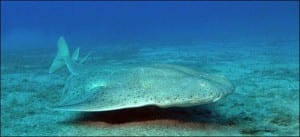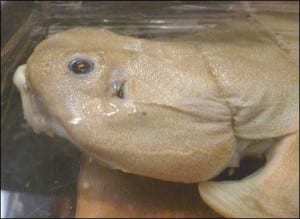Specimen of the Week: Week Forty-Eight
By Emma-Louise Nicholls, on 10 September 2012
 Every Monday I chose my Specimen of the Week with the care and attention of a model kit expert applying the last decal. We have 4000+ specimens on display and every week I get to draw your attention to just one. The specimen may be chosen for its unusual preservation state, because it represents an intriguing species hanging off the branch of little heard of creatures on the evolutionary tree, or because the specimen featured in my life recently for some reason and endeared itself to me. The last in the list has been the most popular reason to date. This week I was perusing the shelves for specimens to use in a student practical and keeping a sharp eye for the subject of the next Specimen of the Week, when a friend popped in to say ‘hello and how do you do’ to his adopted flying frog. Having exhausted conversation with the largely inanimate amphibian he turned his attention to me and my Specimen of the Week. The subsequent random tangents of conversation resulted in him standing straight, with one arm out pointing, his eyes closed, and spinning in circles as small children ducked out of the way whilst he waited for me to shout ‘STOP’. The next Specimen of the Week lay beyond his finger in the direction to which he pointed. We immediately embarked on a journey of discovery. The first specimen we came across was the dugong, at which point it was decided by unanimous vote that his finger had in fact been pointing over that specimen. Next in line of sight was the whale case, comprising multiple bits and bobs of various parts of the anatomy of several whale species. As we edged closer, wondering what the SotW would turn out to be, we saw it. On the same table as the dugong, in front of the whale case, and clearly what the finger had been trying to tell us it lay unassuming it it’s perspex box. ‘Ah haaaaaaaaa’ I declared aloud, ‘this week’s Specimen of the Week is…’
Every Monday I chose my Specimen of the Week with the care and attention of a model kit expert applying the last decal. We have 4000+ specimens on display and every week I get to draw your attention to just one. The specimen may be chosen for its unusual preservation state, because it represents an intriguing species hanging off the branch of little heard of creatures on the evolutionary tree, or because the specimen featured in my life recently for some reason and endeared itself to me. The last in the list has been the most popular reason to date. This week I was perusing the shelves for specimens to use in a student practical and keeping a sharp eye for the subject of the next Specimen of the Week, when a friend popped in to say ‘hello and how do you do’ to his adopted flying frog. Having exhausted conversation with the largely inanimate amphibian he turned his attention to me and my Specimen of the Week. The subsequent random tangents of conversation resulted in him standing straight, with one arm out pointing, his eyes closed, and spinning in circles as small children ducked out of the way whilst he waited for me to shout ‘STOP’. The next Specimen of the Week lay beyond his finger in the direction to which he pointed. We immediately embarked on a journey of discovery. The first specimen we came across was the dugong, at which point it was decided by unanimous vote that his finger had in fact been pointing over that specimen. Next in line of sight was the whale case, comprising multiple bits and bobs of various parts of the anatomy of several whale species. As we edged closer, wondering what the SotW would turn out to be, we saw it. On the same table as the dugong, in front of the whale case, and clearly what the finger had been trying to tell us it lay unassuming it it’s perspex box. ‘Ah haaaaaaaaa’ I declared aloud, ‘this week’s Specimen of the Week is…’
**!!The Angel Shark!!**
1) Lacking a shiny gold circular aura floating above its head, the angel shark is presumably named for its gigantic pectoral fins that, much like members of the ray family, form large triangular ‘wings’. Clearly due to personality crisis the angel shark looks less like a shark, and much more like an elongate ray. Its body is flat and the dorsal fins are placed way down near the tail. One of the main differences between sharks and rays by the way, is the placement of the gills. All sharks keep their gills on their sides. All rays put their gills underneath the body.
2) Not content with fooling people into thinking it is a ray rather than a shark, this temperate water fish also occasionally tries to pass itself off as a cat. It has short, wide, whisker-like projections (actually called barbels, but that’s less fun) which the shark uses to both taste and feel its environment. For a fantastic effort in the whisker stakes, check out the tasselled wobbegong shark. When your eyes return to a normal size, please read on…
3) The angel shark has evolved this flattened body plan in a bid to contend for the title ‘World’s Best Marine Ambush Predator’. It lies buried and motionless in muddy or sandy areas with little more than its eyes poking up. Vertical slit pupils give the shark excellent all-round vision. When an unsuspecting, or rather, ‘fully-suspecting-but-don’t-have-a-choice-but-to-swim-here’ squid, flatfish or crustacean wanders past, the angel shark bursts forward like an F-4 Phantom Mk II, and grabs it with a mouth full of tiny needle-shaped teeth.
4) Female angel sharks grow to around 1.5 m whilst the smaller males stop needing new shoes around just over a metre. At least one female was recorded measuring just over 2.4 m, though that’s a heavyweight champion who’s been eating too many squid. No disrespect.
5) Until recently, the range of the angel shark spanned Britain, Scandinavia, the Mediterranean, and northern Africa. However, it is now extinct in the North Sea, all but extinct in the Mediterranean, and struggling for numbers in the remainder of this range. Benthic trawling is thought to be the main culprit for its demise. Benthic trawlers catch fish for the commercial market by dragging a fishing net along the sea bed. Unfortunately this pretty darn irresponsible and yet wide spread fishing method destroys habitat and kills individuals of many species, not just the ones that have the commercial value. But what do we care, supermarkets MUST remain stocked up with produce, all so the customer can buy any species they like, whenever they like. Ah, convenience is a wonderful thing. Shame though, that keeping supermarket stocks up means that a large percentage gets thrown away when it passes the sell by date. An empty supermarket fish counter is a pleasing sight as it means they haven’t over stocked. If we as a species only took what we needed, large scale trawling might not be necessary and fishing could be sustainable. Here endeth the lesson.
Emma-Louise Nicholls is the Museum Assistant at the Grant Museum of Zoology
4 Responses to “Specimen of the Week: Week Forty-Eight”
- 1
-
2
Question of the Week: How do sharks hear? | UCL Researchers in Museums wrote on 7 January 2015:

[…] The angel shark, with ears visible just behind the eyes.Courtesy Grant Museum. […]
-
3
Dante wrote on 8 July 2021:
where was this shark found bc i tink it could be the same as the one at my school
-
4
preston wrote on 8 July 2021:
where about was this shark found bc it looks like a shark in my sharks science lab and he has asked me to find out all about it
 Close
Close





What a beautiful little shark & how sad that it is being destroyed by us.